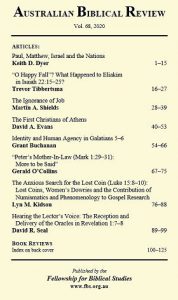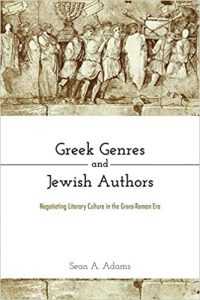É difícil ser mais preciso. Essa declaração de ser incapaz de ser mais preciso sobre a data do javista (J) é o que esperaríamos de um pesquisador honesto. Talvez paradoxalmente, a manutenção de um certo grau de imprecisão possa contribuir para a obtenção de um consenso futuro neste campo. Esse consenso pode não ser satisfatório para aqueles que buscam exatidão, mas refletirá corretamente a natureza do assunto sob investigação, que é uma literatura antiga, cuja origem e desenvolvimento são, pelo menos parcialmente, obscurecidos por séculos de distância.
Alguns trechos de um artigo de Kris Sonek, Senior Lecturer at Catholic Theological College, University of Divinity, Melbourne, Austrália, sobre as narrativas em torno de Abraão e sua família em Gn 12-25.
O texto em português é uma tradução livre. O texto original, em inglês, vem em seguida, porém, sem as notas de rodapé, que podem ser conferidas no artigo, disponível em Academia.edu.
SONEK, K. Wrangling with Abraham: An Evaluation of Recent Studies on Genesis 12–25, Australian Biblical Review, Vol. 67, p. 17-29, 2019.
 O estudo da origem das tradições orais e escritas que deram origem ao surgimento do Gênesis no final da época persa ou no início da época helenística continua a preocupar muitos estudiosos. Embora abordagens interpretativas como leitura pós-colonial, leitura feminista ou hermenêutica ecológica estejam em voga, a leitura histórico-crítica tradicional e sua busca para identificar o contexto original do material bíblico continua a gerar interesse e controvérsia. No entanto, parece que os esforços dos estudiosos modernos para chegar a um consenso sobre a origem do Gênesis e do Pentateuco em geral não tiveram sucesso. Embora alguns autores tenham expressado a opinião de que um entendimento comum do processo histórico foi alcançado até o final do século XX, a atual multiplicação de teorias concorrentes e contraditórias lança uma longa sombra sobre o campo histórico, e muitos leitores modernos se voltam para outras metodologias na esperança de encontrar melhores respostas para suas perguntas.
O estudo da origem das tradições orais e escritas que deram origem ao surgimento do Gênesis no final da época persa ou no início da época helenística continua a preocupar muitos estudiosos. Embora abordagens interpretativas como leitura pós-colonial, leitura feminista ou hermenêutica ecológica estejam em voga, a leitura histórico-crítica tradicional e sua busca para identificar o contexto original do material bíblico continua a gerar interesse e controvérsia. No entanto, parece que os esforços dos estudiosos modernos para chegar a um consenso sobre a origem do Gênesis e do Pentateuco em geral não tiveram sucesso. Embora alguns autores tenham expressado a opinião de que um entendimento comum do processo histórico foi alcançado até o final do século XX, a atual multiplicação de teorias concorrentes e contraditórias lança uma longa sombra sobre o campo histórico, e muitos leitores modernos se voltam para outras metodologias na esperança de encontrar melhores respostas para suas perguntas.
As opiniões de John Van Seters sobre o javista (J) há muito dominam este campo, e alguns estudiosos as consideram muito convincentes. Outros, especialmente aqueles influenciados por argumentos propostos por Rolf Rendtorff e Erhard Blum, negam a existência do javista e explicam a origem e o crescimento do Pentateuco como resultado do trabalho pós-exílico de autores deuteronomistas e sacerdotais expandindo e editando material exílico e pré-exílico dos últimos anos da monarquia. Embora Reinhard G. Kratz esteja certo ao dizer que somente para o Sacerdotal e o Deuteronômio se pode sugerir uma base textual segura que seja capaz de obter um consenso, certamente gostaríamos de ver um nível mais alto de consenso entre os estudiosos que fazem uma abordagem histórico-crítica. Estabelecer o sentido literal das passagens de um escrito depende também de sua data. Portanto, se discordamos sobre a época de sua composição, dificilmente podemos propor uma exposição convincente de seu sentido literal.
Além do mais, a pesquisa recente de David M. Carr demonstrando a dificuldade de colocar as tradições de Abraão na linha do tempo leva à conclusão de que o sentido literal de Gênesis 12-25 pode ser verificado com apenas um grau limitado de probabilidade. Carr argumenta que o complexo de tradições abraâmicas constitui um exemplo primordial em que os textos da Bíblia Hebraica de significância teológica demonstrável são relativamente difíceis de colocar em um continuum cronológico neste tipo de história. Afinal, a questão de saber se esses textos e suas tradições orais subjacentes são pré ou pós-exílicos é crucial para estabelecer seu sentido literal. O trabalho dos neodocumentários, como Joel S. Baden, adiciona mais uma camada de incerteza a esta questão já discutida. Assim como a contribuição de Van Seters, as visões dos neodocumentários são internamente consistentes, mas sua incompatibilidade com teorias rivais leva à fragmentação da paisagem acadêmica histórico-crítica.
O caráter conjetural dos estudos histórico-críticos é outro fator que deve ser levado em consideração aqui. Richard E. Averbeck, por exemplo, diz que o livro sobre o Gênesis de Konrad Schmid tem muito especulação, o que dá a impressão de que o autor está moldando a leitura das passagens para se adequar à sua teoria, e não o contrário. Talvez Schmid não mereça essa crítica, mas os comentários de Averbeck certamente se aplicam a muitos estudos histórico-críticos do Pentateuco. Como resultado, as tentativas atuais de explicar a origem e o crescimento dos textos do Pentateuco são altamente especulativas. A pesquisa sobre a formação do Pentateuco leva a novas hipóteses sobre esse complicado processo, mas sem um consenso firme. Agora, por definição, os fatos nunca podem ser provados como falsos. São hipóteses que são constantemente revisadas e, se necessário, consideradas falsas. Isso é algo que precisamos ter em mente quando nos envolvemos com os estudos histórico-críticos modernos no contexto das narrativas de Abraão. Na maioria das vezes, lidamos com teorias altamente conjecturais, que podem ser testadas e avaliadas, mas nunca devem ser apresentadas como fatos.
(…)
Os comentários de John J. Collins sobre o material do Pentateuco são um bom exemplo a ser seguido, por serem muito cuidadosos. Ele diz que os debates recentes sobre o Pentateuco mostram que a reconstrução de formas anteriores do texto bíblico é um empreendimento altamente especulativo. Talvez a principal lição a ser aprendida é que esses textos são de fato compostos e incorporam camadas de diferentes épocas. Carr também é cauteloso quando se trata de datar as camadas textuais das narrativas de Abraão. Ele admite que seu trabalho visa mais modéstia metodológica do que caracterizou muitas reconstruções anteriores do desenvolvimento de textos na Bíblia Hebraica. Ele então especula que as tradições de Abraão em Gênesis 12-25 podem ser pré-exílicas, mas ele também afirma que é difícil atribuir datas específicas a essas tradições misturadas e fortemente editadas. Em outras palavras, Carr afirma que, na maioria das vezes, temos que trabalhar com uma aproximação do processo histórico ao invés de tentar estabelecer seus detalhes exatos.
Mesmo um breve levantamento do campo histórico-crítico sugere que os estudiosos devem examinar sua metodologia para evitar construir um argumento com base em pressuposições questionáveis. Teorias baseadas em suposições implausíveis ou não comprovadas podem ser elaboradas ou podem parecer novas, mas seu valor real é limitado. Tenho a forte convicção de que os estudos literários modernos e a hermenêutica bíblica fornecem uma orientação excelente a esse respeito. Dado que os estudos bíblicos sempre refletiram a crítica secular até certo ponto, como Barton convincentemente argumenta, os estudiosos da Bíblia podem aprender com os críticos literários sobre os pontos fortes e as limitações de seu método. T. S. Eliot escreve em The Varieties of Metaphysical Poetry que devemos sempre ser tão exatos e claros quanto possível – tão claros quanto o assunto permite. E quando o assunto é literatura, a clareza além de um determinado ponto torna-se falsificação. Esta é uma restrição muito importante à atividade de crítica literária. Quando um assunto é vago por natureza, a clareza deve consistir, não em torná-lo tão claro a ponto de ser irreconhecível, mas em reconhecer a sua imprecisão.
Parece que John A. Emerton encontra o equilíbrio certo entre ser exato e reconhecer as limitações de seu assunto quando resume sua investigação da data do javista: “Se minha hipótese de que a matriz da escrita da história israelita pode ter sido a tradição literária vista nas inscrições semíticas do noroeste dos séculos nono ao sétimo, a composição do javista (J) pode ser plausivelmente associada a ela. É difícil ser mais preciso ” (p. 128). Essa declaração de ser incapaz de ser “mais preciso” é o que esperaríamos de um pesquisador honesto. Talvez paradoxalmente, a manutenção de um certo grau de imprecisão possa contribuir para a obtenção de um consenso futuro neste campo. Esse consenso pode não ser satisfatório para aqueles que buscam exatidão, mas refletirá corretamente a natureza do assunto sob investigação: literatura antiga cuja origem e desenvolvimento são, pelo menos parcialmente, obscurecidos por séculos de distância.
Algum autores citados no texto
BADEN, J. S. The Composition of the Pentateuch: Renewing the Documentary Hypothesis. New Haven: Yale University Press, 2012.
BARTON, J. Reading the Old Testament: Method in Biblical Study. London: Darton Longman & Todd, 1984.
BLUM, E. Die Komposition der Vätergeschichte. Neukirchen-Vluyn: Neukirchener Verlag, 1984; Studien zur Komposition des Pentateuch. Berlin: Walter de Gruyter, 1990.
CARR, D. M. The Formation of the Hebrew Bible: A New Reconstruction. New York: Oxford University Press, 2011.
COLLINS, J. J. Introduction to the Hebrew Bible. Minneapolis: Augsburg Fortress, 2004.
DOZEMAN, T. B.; SCHMID, K. (eds.) A Farewell to the Yahwist? The Composition of the Pentateuch in Recent European Interpretation. Atlanta: Society of Biblical Literature, 2006.
EMERTON, J. A. The Date of the Yahwist. In: DAY, J. (ed.) In Search of Pre-Exilic Israel: Proceedings of the Oxford Old Testament Seminar. London: T&T Clark, 2004, p. 107–129.
KRATZ, R. G. The Growth of the Old Testament. In: ROGERSON, J. W. ; LIEU, J. M. (eds.) The Oxford Handbook of Biblical Studies. Oxford: Oxford University Press, 2006, p. 459–488.
RENDTORFF, R. Das überlieferungsgeschichtliche Problem des Pentateuch. Berlin: Walter de Gruyter, 1977. Tradução inglesa: The Problem of the Process of Transmission in the Pentateuch. Sheffield: Sheffield Academic Press, 1990.
SCHMID, K. Genesis and the Moses Story: Israel’s Dual Origins in the Hebrew Bible. Winona Lake: Eisenbrauns, 2010.
SONEK, K. The Abraham Narratives in Genesis 12–25. Currents in Biblical Research, Volume 17, Issue 2, February 2019, p. 158-183.
VAN SETERS, J. Abraham in History and Tradition. New Haven: Yale University Press, 1975 e Brattleboro, VT: Echo Point Books & Media, 2014.
VAN SETERS, J. Prologue to History: The Yahwist as Historian in Genesis. Louisville, Kentucky: Westminster John Knox, 1992.
VAN SETERS, J. The Pentateuch: A Social-Science Commentary. 2. ed. London: Bloomsbury T & T Clark, 2015.
Recomendo a leitura de:
SONEK, K. The Abraham Narratives in Genesis 12–25, Currents in Biblical Research, Vol. 17(2), p. 158–183, 2019.
The study of the origin of the oral and written traditions which gave rise to the emergence of Genesis in the late Persian or early Hellenistic periods continues to preoccupy many scholars. Though such interpretative approaches as postcolonial criticism, feminist criticism, or ecological hermeneutics are in vogue, the traditional historical criticism and its quest to identify the original context of the scriptural material continues to generate both interest and controversy. Nevertheless, it seems that the efforts of modern scholars to reach a consensus on the origin of Genesis, and the Pentateuch in general, have been largely unsuccessful. Though some authors have expressed the view that a common understanding of the historical process was achieved by the end of the twentieth century, the current multiplication of competing and contradictory theories casts a long shadow on the historical field, and many modern readers turn to other methodologies in the hope of finding better answers to their questions.
many scholars. Though such interpretative approaches as postcolonial criticism, feminist criticism, or ecological hermeneutics are in vogue, the traditional historical criticism and its quest to identify the original context of the scriptural material continues to generate both interest and controversy. Nevertheless, it seems that the efforts of modern scholars to reach a consensus on the origin of Genesis, and the Pentateuch in general, have been largely unsuccessful. Though some authors have expressed the view that a common understanding of the historical process was achieved by the end of the twentieth century, the current multiplication of competing and contradictory theories casts a long shadow on the historical field, and many modern readers turn to other methodologies in the hope of finding better answers to their questions.
John Van Seter’s views on the Yahwist have long dominated this field, and some scholars have found them very convincing. Others, especially those influenced by arguments proposed by Rolf Rendtorff and Erhard Blum, deny the existence of the Yahwist, and explain the origin and growth of the Pentateuch as a result of the post-exilic work of Deuteronomistic and Priestly authors expanding and editing exilic and late pre-exilic material. While Reinhard G. Kratz is right in saying that “only for the Priestly Writing and Deuteronomy can one suggest a sure textual basis that is capable of gaining a consensus,” [Kratz, 2006, p. 482] we would certainly like to see a higher level of consensus among historical scholars. Establishing the literal sense of scriptural passages depends on their dating. Hence if we disagree about the time of their composition, we can hardly propose a convincing exposition of their literal sense.
What is more, David M. Carr’s recent research demonstrating the difficulty of placing the Abraham traditions on the timeline leads to the conclusion that the literal sense of Genesis 12–25 can be ascertained with only a limited degree of probability. Carr argues: “Overall, the complex of Abrahamic traditions constitutes a prime instance where texts in the Hebrew Bible of demonstrable theological significance are relatively difficult to place on a chronological continuum in this sort of history.” [Carr, 2011, p. 485] After all, the question of whether these texts and their underlying oral traditions are pre- or post-exilic is crucial for establishing their literal sense. The work of the “neo-documentarians,” such as Joel S. Baden, adds a further layer of uncertainty to this already moot issue. Like the contribution of Van Seters, the neo-documentarians’ views are internally consistent, but their incompatibility with rival theories leads to the fragmentation of the historical-critical academic landscape.
The conjectural character of historical-critical studies is another factor which needs to be taken into consideration here. Richard E. Averbeck comments on Konrad Schmid’s Genesis and the Moses Story: “There is a lot speculation in this book. One sometimes gets the impression that the author is shaping the reading of passages to fit his theory rather than the other way around” [Averbeck, 2011, p. 167]. I do not think that Schmid deserves this criticism, but Averbeck’s comments certainly apply to many historical-critical studies of the Pentateuch. As a result, the current attempts to explain the origin and growth of pentateuchal texts are highly speculative. The research on the formation of the Pentateuch leads to new hypotheses about this complicated process, but without any firm consensus. Now, by definition, facts can never be proved false. It is hypotheses that are constantly revised and occasionally falsified. This is something we need to keep in mind when we engage with modern historical-critical scholarship in the context of the Abraham narratives. More often than not, we deal with highly conjectural theories, which can be tested and evaluated, but should never be presented as facts.
(…)
By contrast, John J. Collins’s comments on the pentateuchal material are very circumspect: “Nonetheless, the recent debates about the Pentateuch show that the reconstruction of earlier forms of the biblical text is a highly speculative enterprise. Perhaps the main lesson to be retained is that these texts are indeed composite, and incorporate layers from different eras” [Collins, 2004, p. 63]. Carr is also cautious when it comes to dating the textual layers of the Abraham narratives. He admits that his work “is aiming for more methodological modesty than has characterized many prior reconstructions of the development of texts in the Hebrew Bible” [Carr 2011, p. 4]. He then speculates that the Abraham traditions in Genesis 12–25 may be pre-exilic, but he also states that it is difficult to assign specific dates to those mixed and heavily edited traditions. In other words, Carr declares that, more often than not, we have to work with an approximation of the historical process rather than trying to establish its exact details.
Even a brief survey of the historical-critical field suggests that scholars should examine their methodology to avoid building an argument on the basis of questionable presuppositions. Theories grounded in implausible or unproven assumptions may be elaborate or may sound novel, but their real value is limited. It is my strong conviction that modern literary studies and biblical hermeneutics provide excellent guidance in this respect. Given that “biblical studies have always mirrored secular criticism to some extent”, as Barton convincingly argues [Barton 1984, p. 204], the biblical guild may learn from literary critics about the strengths and limitations of their method. T. S. Eliot writes in The Varieties of Metaphysical Poetry: “One must always be as exact and clear as one can—as clear as one’s subject matter permits. And when one’s subject matter is literature, clarity beyond a certain point becomes falsification. This is a very important restriction on the activity of literary criticism. When a subject matter is in its nature vague, clarity should consist, not in making it so clear as to be unrecognisable, but in recognising the vagueness, where it begins and ends and the causes of its necessity, and in checking analysis and division at the prudent point.” [Eliot, 1993, p. 59-60]
It seems that John A. Emerton finds the right balance between being exact and recognizing the limitations of one’s subject matter when he summarizes his investigation of the date of the Yahwist: “If my hypothesis that the matrix of Israelite history writing was the literary tradition seen in North-West Semitic inscriptions of the ninth–seventh centuries is correct, then the composition of J may plausibly be associated with it. It is difficult to be more precise” [Emerton, 2004, p. 128]. This statement of being unable to be “more precise” is what we would expect from an honest scholar. Perhaps paradoxically, maintaining a certain degree of imprecision may contribute to achieving a future consensus in this field. That consensus may not prove satisfactory to those who seek exactitude, but it will correctly reflect the nature of the subject under investigation: ancient literature whose origin and development are, at least partially, obscured by centuries-long historical distance.
 literatura do Antigo Testamento se encontra na historiografia deuteronomista (DtrG), um conjunto literário que abrange todos os livros a começar pelo Deuteronômio até o Segundo Livro dos Reis. (…) A obra historiográfica dtr começa, em Dt 1-4, por um grande discurso de Moisés no qual são recapituladas as etapas da história de Israel desde a saída do Egito até as vésperas da conquista. No quadro do consenso “clássico” sempre se achou que esta recapitulação se referia ao relato dos livros do Gênesis (no que trata da promessa feita aos pais), do Êxodo e dos Números, por conseguinte um relato que se pressupunha existir. Ora, Martin Rose (Deuteronomist und Jahwist. Untersuchungen zu den Berührungspunkten beider Literaturwerke, Zürich, 1981) conseguiu tornar verossímil uma outra hipótese, a saber, que os relatos de Gênesis a Números foram compostos precisamente para dar a esse discurso seu ponto de referência literário: os livros de Gênesis a Números seriam portanto posteriores a DtrG [sublinhado meu]. Este tese teve uma confirmação recentemente num estudo de Thomas Römer (Israel Väter. Untersuchungen zur Väterthematik im Deuteronomium und in der deuteronomistischen Tradition , Freiburg/Göttingen, 1990) que demonstrou que os “pais” aos quais se refere a historiografia dtr e o livro de Jeremias não são os patriarcas do Gênesis, mas as gerações que saíram do Egito [sublinhado meu]. Portanto não temos mais bases que nos permitam afirmar a existência, na época pré-exílica, de um conjunto literário relatando a história desde a criação do mundo até a entrada dos israelitas em Canaã.
literatura do Antigo Testamento se encontra na historiografia deuteronomista (DtrG), um conjunto literário que abrange todos os livros a começar pelo Deuteronômio até o Segundo Livro dos Reis. (…) A obra historiográfica dtr começa, em Dt 1-4, por um grande discurso de Moisés no qual são recapituladas as etapas da história de Israel desde a saída do Egito até as vésperas da conquista. No quadro do consenso “clássico” sempre se achou que esta recapitulação se referia ao relato dos livros do Gênesis (no que trata da promessa feita aos pais), do Êxodo e dos Números, por conseguinte um relato que se pressupunha existir. Ora, Martin Rose (Deuteronomist und Jahwist. Untersuchungen zu den Berührungspunkten beider Literaturwerke, Zürich, 1981) conseguiu tornar verossímil uma outra hipótese, a saber, que os relatos de Gênesis a Números foram compostos precisamente para dar a esse discurso seu ponto de referência literário: os livros de Gênesis a Números seriam portanto posteriores a DtrG [sublinhado meu]. Este tese teve uma confirmação recentemente num estudo de Thomas Römer (Israel Väter. Untersuchungen zur Väterthematik im Deuteronomium und in der deuteronomistischen Tradition , Freiburg/Göttingen, 1990) que demonstrou que os “pais” aos quais se refere a historiografia dtr e o livro de Jeremias não são os patriarcas do Gênesis, mas as gerações que saíram do Egito [sublinhado meu]. Portanto não temos mais bases que nos permitam afirmar a existência, na época pré-exílica, de um conjunto literário relatando a história desde a criação do mundo até a entrada dos israelitas em Canaã. Esse novo “dado” das teorias sobre o Pentateuco incide decisivamente sobre o nosso enfoque dos relatos de Gn 12-35. Antes de mais nada, a reorganização da articulação entre Tetrateuco e DtrG tem como consequência estabelecer que a história dos três patriarcas é, em sua própria concepção, posterior a DtrG, portanto pós-exílica, e que doravante ela pertence à fase mais tardia da constituição do Pentateuco [sublinhado meu]. Mas isto não significa que no interior de Gn 12-35 tudo seja da mesma proveniência e que alguns de seus componentes não possam remontar a uma época muito mais antiga.
Esse novo “dado” das teorias sobre o Pentateuco incide decisivamente sobre o nosso enfoque dos relatos de Gn 12-35. Antes de mais nada, a reorganização da articulação entre Tetrateuco e DtrG tem como consequência estabelecer que a história dos três patriarcas é, em sua própria concepção, posterior a DtrG, portanto pós-exílica, e que doravante ela pertence à fase mais tardia da constituição do Pentateuco [sublinhado meu]. Mas isto não significa que no interior de Gn 12-35 tudo seja da mesma proveniência e que alguns de seus componentes não possam remontar a uma época muito mais antiga. Jacó tem por função explicar as origens do povo de Israel e de sua entrada na terra de Canaã. Este relato das origens se basta a si mesmo e não exige qualquer sequência (nem história de José, nem saída do Egito etc). Oseias 12 nos mostra aliás que o profeta pretende opor à versão “patriarcal” das origens de Israel uma outra versão, “profética”: a da saída do Egito, que é colocada sob a égide de um profeta, e não de um ancestral (Os 12,14). Cabe a Israel escolher suas origens! Não sabemos se, à época de Oseias, os dois relatos de origem já haviam sido ligados, de uma ou de outra maneira, um ao outro. A verdade é que essas duas versões são concorrentes e que originalmente cada qual se bastava a si mesma [sublinhado meu].
Jacó tem por função explicar as origens do povo de Israel e de sua entrada na terra de Canaã. Este relato das origens se basta a si mesmo e não exige qualquer sequência (nem história de José, nem saída do Egito etc). Oseias 12 nos mostra aliás que o profeta pretende opor à versão “patriarcal” das origens de Israel uma outra versão, “profética”: a da saída do Egito, que é colocada sob a égide de um profeta, e não de um ancestral (Os 12,14). Cabe a Israel escolher suas origens! Não sabemos se, à época de Oseias, os dois relatos de origem já haviam sido ligados, de uma ou de outra maneira, um ao outro. A verdade é que essas duas versões são concorrentes e que originalmente cada qual se bastava a si mesma [sublinhado meu].






